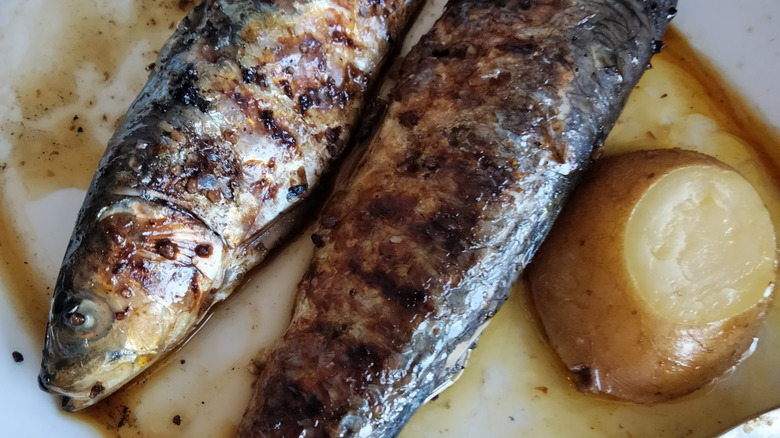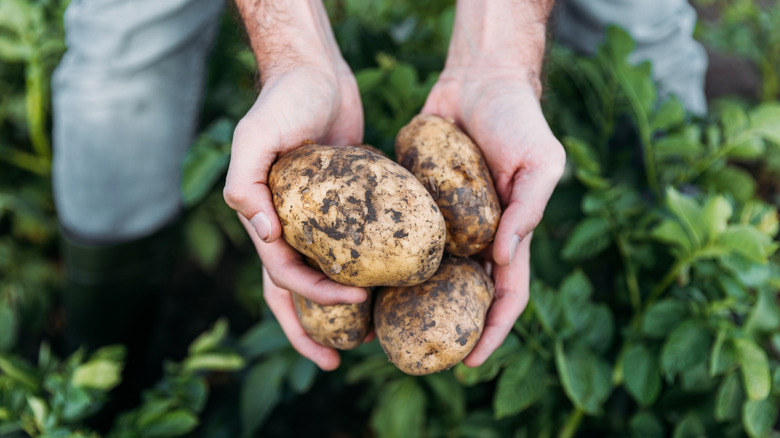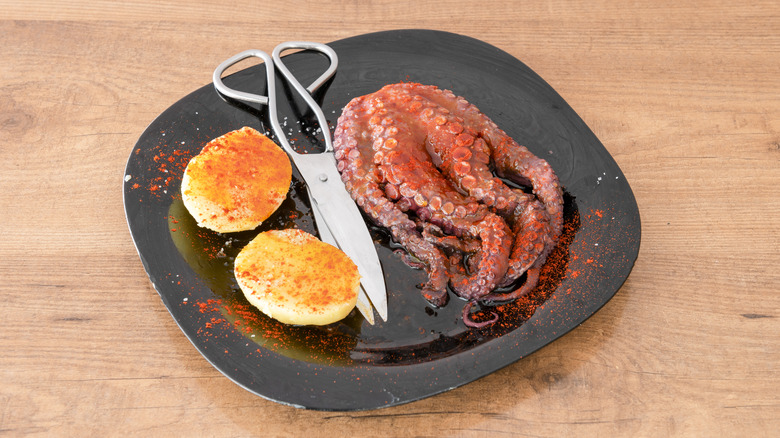Cachelos, The Galician Potatoes That Pair Well With Seafood
Sitting in the far western corner of Spain north of Portugal, Galicia is somewhat of a land apart with vast coastlines that jut out into the Atlantic ocean. The culture is a mixture of Spanish and Celtic traditions, and the people are fiercely proud of their identity and all that makes them and their region unique. Of course, that includes the food, and as you can imagine, fishing and seafood play a major role in Galician cuisine. But, just as one can't survive on fish alone, so too have the Galicians concocted a notable selection of dishes featuring ingredients derived from the land. One such dish that pairs particularly well with the numerous seafood dishes of the region is an understated potato dish called cachelos.
Wander into traditional restaurants in Galician towns like Santiago de Compostela or Pontevedra and you'll be greeted with humble plates of food that allow the honest flavors to take center stage. In pulpo a la Gallega, for example, boiled octopus and potatoes are sliced and served with nothing more than paprika, olive oil, and salt. And flaky, white hake — merluza in Spanish — comes with a sauce of garlic and peppers over cachelos, the potatoes that hew closely to the Galician tradition of unfussy, yet elegant, cooking.
History of cachelos
You may be asking what is so special about cachelos. For starters, Galicia itself is important to the story of potatoes in general in Europe. As Spanish conquistadors marauded their way across South America, they looted a great many treasures, not all of them golden or silver. They also took back to their kingdom heretofore unknown foodstuffs, including the potato, which is native to Peru and other parts of northern South America. Originally thought of as fodder for livestock and ill humans, the first potatoes grown in Europe are believed to have been planted at a monastery in Galicia.
Historically speaking, the word cachelos is derived from the word cachos, or "pieces." This is a reference to the rough pieces of potato not destined for planting that Galicians would eat — simply boiled — in the lean years after the Spanish Civil War. As such, it isn't imperative that the potatoes for cachelos be delicately cut to exacting portions. In fact, in some parts of Galicia the potatoes aren't cut at all, but rather crushed before being boiled.
Today, the Galician potato used to make cachelos, a type of Kennebec, is a certified, protected agricultural product. Medium-sized and oval, the Galician potato is a waxy variety with a thin, light-yellow jacket and flesh that is creamy, yet firm after cooking.
How to cook and serve cachelos
To say that almost anyone could make cachelos isn't an insult; it is a testament to Galician cuisine's focus on the ingredients themselves. Cachelos are boiled potatoes. They aren't finished in the oven for a crispy exterior or fried in duck fat for added richness. Rustic chunks of potato get perfectly tender in a simmering pot along with a few bay leaves to add an herbal note to the whole affair. How you go about making cachelos depends on who in Galicia you ask, as different regions have different approaches.
Either way, crushed or cut in half, for proper cachelos, the skin is left on for added texture and flavor. The potatoes, along with salt and a bay leaf, go into a pot of room temperature water that is brought to a boil and allowed to simmer until the cachelos are done. After being drained, they are set back on the stovetop so that the residual heat will render them fully dry.
As mentioned above, cachelos are frequently served with hake, but you'll find them alongside many seafood dishes. Most commonly, the boiled potatoes serve as an accompaniment to octopus. The thin slices of boiled octopus with olive oil, crunchy salt, and smoky paprika is balanced by the mellow, starchy potato.


